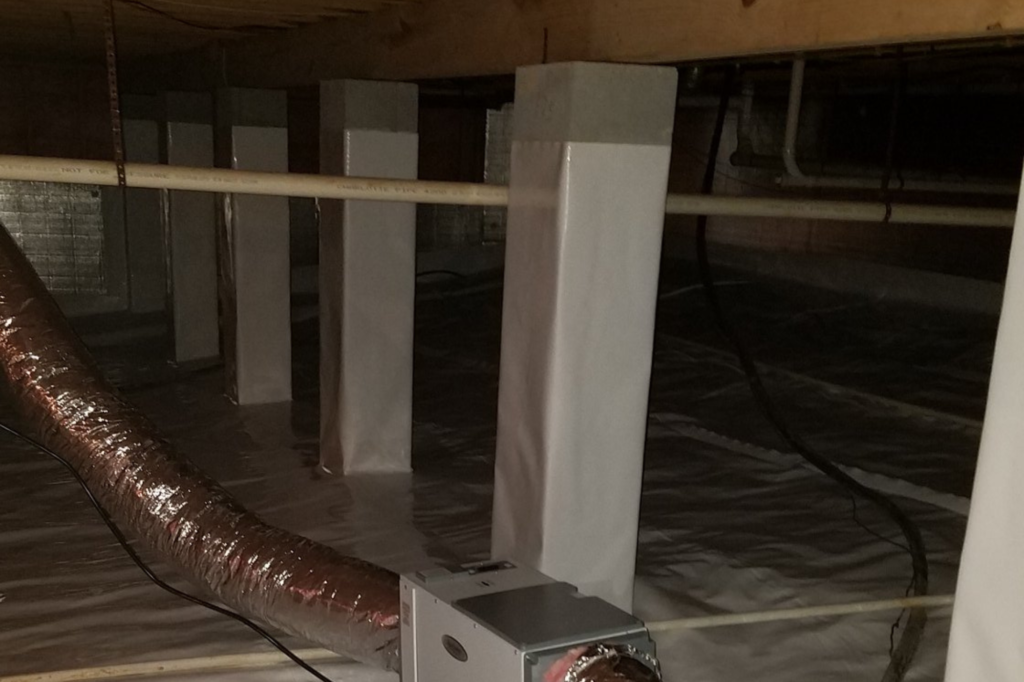Your crawl space getting wet can be a serious issue, often signaling potential hazards like mold, structural damage, and pest infestations. This can stem from poor drainage, plumbing leaks, or condensation. Signs to watch out for include musty odors, visible mold, high humidity, and sagging floors. Address these issues immediately by improving drainage, repairing leaks, or installing a dehumidifier. An effective preventive measure may be encapsulating the area with a vapor barrier. These strategies can help maintain a healthy, dry crawl space. Discover more about keeping this vital area of your home’s infrastructure as you explore deeper.
Key Takeaways
- Wet crawl spaces can result from poor drainage, plumbing leaks, condensation, or high humidity.
- Common signs include musty odors, visible mold, sagging floors, or water pools in the crawl space.
- Moisture in crawl spaces can cause mold, structural damage, increased energy bills, and pest infestations.
- Remedies include identifying and rectifying moisture sources, installing drainage systems, repairing leaks, and using dehumidifiers.
- Prevention strategies involve regular inspections, installing vapor barriers, ensuring proper ventilation, and maintaining gutters.
Understanding Crawl Spaces
Crawl spaces are an integral part of many homes, a feature you may not give much thought to until an issue arises. This hidden area beneath your house serves multiple functions, such as providing access for plumbing, electrical wiring, and HVAC systems. However, because of its location, it’s often the first place to suffer from moisture problems. When your crawl space is wet, it can lead to a host of issues. Mold growth, structural damage, foul smells, and pest infestations are just a few examples. That’s why in cities like Richmond, crawl space waterproofing Richmond is considered a vital part of home maintenance. It’s important to know the signs of a wet crawl space. Musty odors, sagging floors, high humidity, and visible mold are all clear indicators that you need crawl space repair services. Ignoring these signs can result in costly damage and potential health hazards.
Common Causes of Wet Crawl Spaces
Understanding why your crawl space is damp is the first step in fixing the problem. Some common causes include poor drainage, plumbing leaks, or condensation due to high humidity levels. Poor drainage can result from improper landscaping or a lack of gutters and downspouts, causing water to pool around your home’s foundation and seep into the crawl space. If you’re facing these issues, seeking Richmond crawl space waterproofing services is the first step in addressing the problem. Plumbing leaks, both minor and major, can also contribute to dampness, and a professional can help identify and fix leaks before they lead to significant damage. Lastly, condensation occurs when warm, humid air comes in contact with the cooler crawl space surfaces. For homeowners in Richmond, a professional service ensures that moisture issues are accurately diagnosed and effectively resolved.
Identifying Signs of Moisture
To effectively tackle a moisture problem in your crawl space, it’s crucial to recognize the signs of excess dampness. You’ll need to know what to look for to make an accurate diagnosis.
The most obvious sign is visible water. If you find pools of water or damp areas on the ground, that’s an immediate indicator.
It’s important, though, not to ignore less obvious signs. These can include dampness or condensation on walls, pipes, or joists.
Musty odors are another tell-tale sign. This smell is commonly associated with mold and mildew growth, which thrive in damp conditions. If you detect this scent, you’re likely having moisture issues.
For crawl space waterproofing Richmond, make sure to inspect these signs regularly to catch any problems early.

The Impact of a Damp Crawl Space
While spotting signs of dampness can be quite alarming, what this moisture can do to your crawl space and your home should truly concern you.
A damp crawl space can wreak havoc on your home in several ways. To begin with, it becomes a breeding ground for mold and mildew. These fungi not only cause structural damage to your home but can also pose serious health risks to you and your family.
Persistent mold exposure can lead to respiratory issues, allergies, and even more serious conditions.
Next, the excess moisture can lead to wood rot. This compromises the structural integrity of your home, leading to costly repairs down the line. In addition, moisture attracts pests such as termites, which can cause additional damage.
Finally, a damp crawl space can greatly increase your energy bills. Moisture acts as a conductor, allowing your home’s heat to escape during the winter and cool air to escape during the summer.
Effective Solutions for a Wet Crawl Space
Although a wet crawl space can spell disaster for your home, there are effective solutions to help mitigate these issues. The first step is to identify the source of the moisture. This could be due to poor drainage, a leaky pipe, or even condensation. Once you’ve pinpointed the issue, you can address it directly.
If the problem is poor drainage, consider installing a crawl space drainage system or a sump pump. These systems collect and redirect water away from your home, keeping your crawl space dry.
If a leaky pipe is the culprit, have it repaired immediately to prevent further damage.
For condensation issues, a crawl space dehumidifier could be your best bet. These devices control humidity levels, reducing the likelihood of mold and mildew growth.
In some severe cases, encapsulation may be necessary. This process involves sealing your crawl space with a vapor barrier, preventing moisture from entering.
Finally, remember to insulate your crawl space. Insulation prevents heat loss and helps keep out unwanted moisture.
Preventing Future Crawl Space Issues
Ensuring that your crawl space remains dry in the future involves proactive measures and routine maintenance.
You must regularly inspect your crawl space for any signs of dampness, mold, or pests. If you notice anything unusual, don’t hesitate to call a professional.
Invest in a good-quality vapor barrier. This is a plastic or foil sheet designed to prevent moisture from seeping into your crawl space from the ground. It’s an effective way to keep your crawl space dry, but it must be installed properly to work.
Consider installing a dehumidifier. These are specifically designed to reduce moisture levels in your crawl space, preventing mold and mildew growth. Choose a model suitable for the size of your crawl space and with an automatic shut-off feature when the desired humidity level is reached.
Ensure proper ventilation. This allows air to circulate, preventing stagnant air and moisture build-up. However, in humid climates, you may need to close off vents during humid months to prevent additional moisture from entering.
Finally, maintain your gutters and downspouts. They direct rainwater away from your foundation, preventing it from seeping into your crawl space.
In Summary
In summary, dealing with a wet crawl space isn’t a task to overlook. It’s essential to understand the common causes and identify signs early to prevent possible damage. A damp crawl space can greatly affect your home’s health. Implementing effective solutions and taking measures to avoid future issues can safeguard your property. Remember, a dry and well-maintained crawl space is key to a healthy, comfortable home. For professional crawl space repair in Richmond, trust Tiger C Construction to provide the expertise and services you need to ensure your home remains safe and sound.
